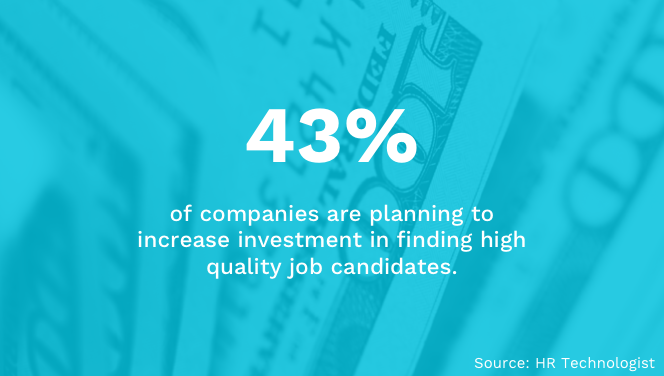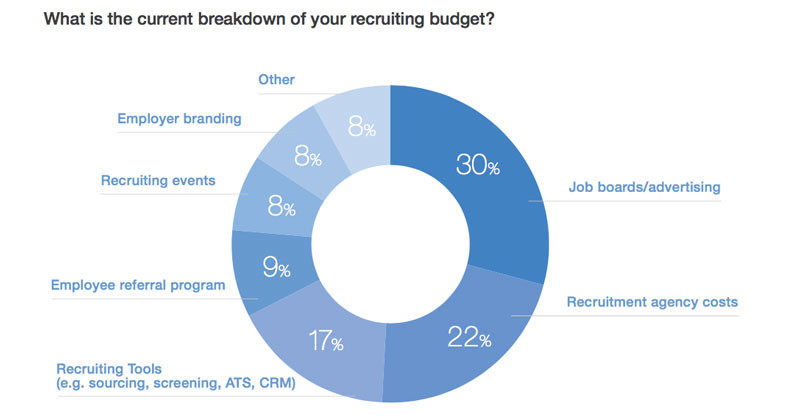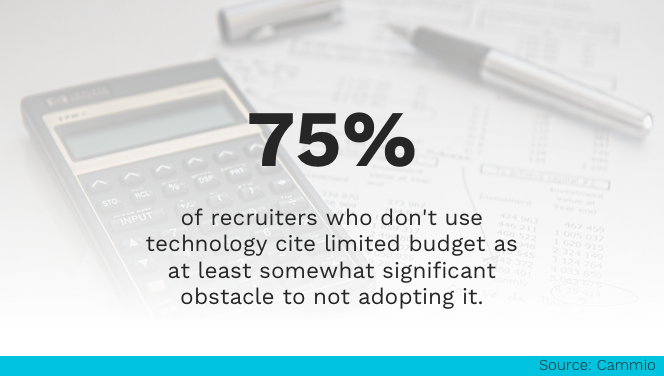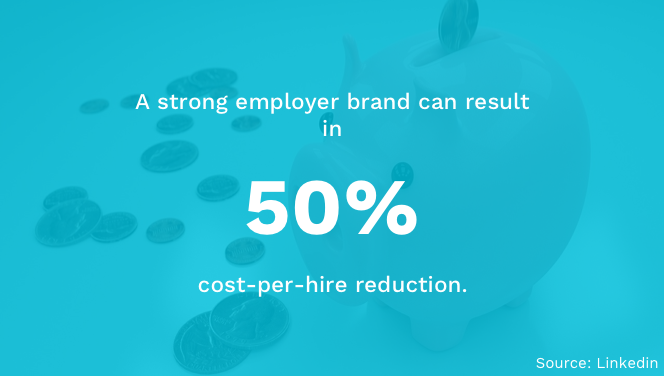Recruiting new hires is one of the most important investments any company can make. But hiring new people also costs money. In fact, The Society of Human Resource Management estimates that the average cost of hiring a new employee is $4,425!
That’s a lot of dough.
And this goes up to over $14,000 for executive hires.
Whatever the exact costs are, it’s clear to see – not only does recruitment take time, but it’s also expensive. All the more reason to get it right the first time and within budget.
In light of all that, how can you ensure you’re making your recruitment budget work for you? Take a look at our seven-step guide and find out.
What’s in?
- Determine your annual recruitment plan for new hires
- Break down your expenditure
- Keep a trained eye on your historic/fixed costs
- Don’t forget technology costs
- Track your time and costs
- Get your staff on board
- Get your budget approved by leadership
Like what you see?
Don’t miss out. Subscribe to our quarterly digest to get the latest TA and TM resources delivered right to your inbox.
But first, let’s clarify:
What’s a recruitment budget?
In short, a recruitment budget is an exhaustive annual estimate of the total cost of hiring at your organization consisting of internal (e.g. recruiters’ salaries) and external (e.g. recruitment tech stack, advertising expenses) costs. This includes unplanned expenses as a result of staff leaving. Needless to say, your recruitment budget has to align with your organization’s annual and longer-term business strategies, including any ongoing plans set by your CEO and Board of Directors.
So, now we’ve established what a recruitment budget actually is, let’s dive into our step-by-step guide to ensuring yours works for you.

Talent acquisition teams also want to invest in maintaining strong employer brands, making the hiring process more efficient and creating a positive candidate experience.
1. Determine your annual recruitment plan for new hires
You need to spend lots of time on this step.
To avoid taking a scattergun approach to your recruitment year-on-year, we suggest working out the following:
- How many new hires your company plans on recruiting
- Establishing whether some roles are harder to fill than others. If so, will they cost more?
- Are there any seasonal hires?
- What about high-volume hires, such as graduate recruitment drives?
- What’s your staff turnover?
Knowing the answers to the above questions allows you to build your recruitment plan at least a quarter ahead. Plus, you’ll know how many yearly hires you need to prepare for per department.
Meeting with your department heads and/or hiring managers to estimate the number of hires your company plans to make in the next financial year is crucial to this step.
So, talk to managers about projected annual headcount. Discuss how that tallies with their upcoming objectives and if there are any skills gaps in their teams that need addressing. If there are, spend time drilling down and pinpointing what the missing skills are. You don’t want to spend thousands of dollars recruiting for a role, then to realize the new hire’s the wrong fit.
If you know you have to hire people with particular skills, you may have to source external help, for example, a recruitment agency or a headhunter. If that’s the case, allow extra time for this.
Once you’ve talked to your managers, you’ll be able to plan and budget better the kind of candidates you need to hire. For example, hiring interns or junior staff members will cost less, whereas hiring senior managers and directors will inevitably be more expensive.
Any recruitment professional worth their salt will have a deep understanding of their company’s staff turnover. As part of that understanding, it’s helpful to take into account your overall company demographics and culture before setting your hiring costs. For instance, is your workforce predominantly young, with high turnover? Or is your firm primarily made up of people interested in staying in a secure role, be if they prefer that, or the economy dictates it? Of course, these are two extremes. But, the point we’re making is that understanding your turnover and the reasons for it will help you calculate your yearly costs more accurately.
2. Break down your expenditure
Calculate how much you regularly spend on recruitment by category and on a month-on-month basis. You may find the following headings a useful guide as you go about these calculations:
- Cost per hire
- Job advert costs (e.g., Indeed, Career Builder, industry-specific boards)
- Professional social network hiring costs (e.g., LinkedIn)
- Recruitment software costs (both startup and ongoing expenses)
- Recruitment events and networking including graduate fairs
- Branding (such as company videos, social media, banners, print materials and so on)
- Background checks on potential hires
- External recruitment agency fees (if you use them)
- Interview expenses (candidate travel and accommodation costs, if you offer this to applicants)
- Salaries including a separate heading if you’re hiring temporary agency staff
- Onboarding costs including relocation expenses for candidates (again, if you offer them)
- Training costs (during onboarding and annual development training)
If you have what looks like a seemingly towering annual recruitment figure, don’t be fooled. Taking into account everything in Step 3 (more on that in a sec), and then estimating how you’ll spread out these quarterly costs, including fixed and recurring fees, is really important. The devil’s in the detail, after all.

To get an accurate estimate for your recruitment budget, you need to have a clear overview of the expense categories. On average, job advertising takes up almost a third of the recruitment budget.
3. Keep a trained eye on your historic/fixed costs
Have a clear overview of your past and fixed costs, particularly if you’re committing to larger recruitment drives such as graduate fairs. This will help you understand the most expensive elements of your recruitment costs, including things like your: recruitment tools, agency costs, events, job fairs, HR tech, etc.
You’ll also get a better idea of which recruitment channels worked and brought fruitful results, and more importantly, which didn’t.
As you analyze your fixed costs, be sure to ask yourself: How much was your annual recruitment expenditure, and do you anticipate it increasing? If so, why?
Don’t forget to factor in the cost of paying to attend events on your recruitment calendar such as university recruitment days and job fairs. If you know these events attract great candidates (this is usually the case if you’ve partnered with quality universities), you’ll need to account for these expenses. For instance, you might have to shell out for stands, flyers, banners, etc.
Monies should only be allocated to recruitment strategies that have been successful in the past. Conducting an annual or even quarterly review of these strategies provides the big picture you need to ensure your budget is being put to best use.
Also, your company may have had a big recruitment drive the year before. If that was a one-off, your projected budget needs to be adjusted accordingly.
It’s also worth noting, historic expenses can also include agency costs. If, for example, your organization uses agencies to hire temporary staff, you need to factor those fees in. You may also use agencies to hire more difficult, niche, or senior posts. Typically, agencies charge around 20% of the base salary, but they can be double that if it’s an executive role.
4. Don’t forget technology costs
Embrace innovation. Technology can be a recruiter’s best friend. With the right recruiting software at your disposal, you can save valuable time and effort and increase quality of hire at the same time. Investing in decent recruiting tools that help you sift through unsuitable applications are worth their weight in gold, so don’t miss out on the best hires by omitting this cost from your budget.
Chances are that you’re already using different recruiting tools throughout your hiring process. These include Applicant Tracking Systems, Candidate Relationship Management tools, programmatic job advertising software, pre-employment assessment tools, and others types of technology.
Make a list of all the tools you’re using. When factoring in their costs, take into consideration the pricing models. Do you pay a quarterly or annual fee? Do you pay per candidate? Or have you paid a one-off fee?
Top Tip: Make sure your software integrates with your existing tools. For instance, the background check services you use to check your candidates’ criminal background, education, and previous employers should connect to your ATS or CRM to complete existing candidates’ profiles.

At the same time, a majority of recruiters consider technology extremely or very important for high job performance. That’s why you need to budget for the right tools in your annual spending.
How AI & recruitment technology is changing recruiting experience
Find out how tech has helped other companies grow by enhancing both the recruiters’ and candidates’ experience!
5. Track your time and costs
Remember, your time and that of your recruiting department cost money too. Your budget will work better for you if you know how long it typically takes for your company to hire someone. Research shows that the smaller the company, the longer it takes them to hire. For example, a company with 1-500 employees takes an average of 41 days, whereas a company with 5,000+ staff only takes 25 days.
You can calculate your time to hire with this formula:

Continue with calculating your cost per hire. Determining this is one of the most important calculations you’re going to make when setting your recruitment budget. You can, of course, refer to past budgets to help you with this and then simply add any updated expenses.
Once you know your internal and external recruiting costs, use this formula to help you work out your cost per hire:

6. Get your staff on board
Your existing staff are your ambassadors. So, budget for a staff referral bonus scheme. If you have a robust system that you promote internally and tell candidates about the moment they join you, it can act as a terrific incentive. Rewards could include cash, a day off, a tangible gift like a store or holiday/gym vouchers, or an experiential gift like a cookery course or wine-tasting. Any of these are great motivators for existing staff, so make sure everyone knows about them. Posting about your referral bonus scheme via your internal communications channels, like the staff newsletter and intranet, is a good starting point.
Top Tip: Ensure your online application form has a button/box on it that asks how the candidate found out about the job. Be sure to include “employee referral” as an option and space for that person’s name.
7. Get your budget approved by leadership
Be prepared to present your budget, argue your case, and show your leadership team how invested you are in attracting the best talent there is. Have the facts at your fingertips. You may need to clarify your mission, so have the details of your projected spending and ROI at the forefront of your mind. That way, you’ll be better prepared for any tricky questions that come your way.
It goes without saying, you’ll have to show the value of high-quality hiring to your senior management team. How will this expenditure contribute to the company’s bottom-line/corporate revenue? If you can demonstrate how your company’s strategic goals will be better served by a sound investment in recruitment, you’re halfway there.
Also, if you’re fully apprised of how your company’s competitors are hiring, you could make a case for being able to stay several steps ahead of the game. Go in armed with info about the tools your competitors are using, their recruitment strategies, and how they’re benefitting from them.
Being able to show your leadership team the potential return on investment (ROI) will help you gain budget approval. In other words, how much recruitment costs are per hire vs. how much that hire will bring financially to your company.

Investing more money into employer brand or candidate experience will help you lower costs in other parts of the recruitment process. You need to have a good estimation of the numbers to get your budget approved, so make sure to prepare it in advance.
Ready to start managing your recruitment budget more effectively?
Whether you like it or not, having a sufficient recruitment budget is key to any successful hiring strategy. Most importantly, you need to have a thorough overview of what your expenses are and how you’re going to grow your company. Then you can use this info to help you manage your budget effectively. After all, having a realistic recruitment budget will help you grab the best talent there is for your company.
So, what are you waiting for? Put our seven-step guide into action today, and start managing your recruitment budget more successfully.
How AI & recruitment technology is changing recruiting experience
Find out how tech has helped other companies grow by enhancing both the recruiters’ and candidates’ experience!



